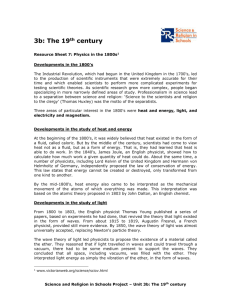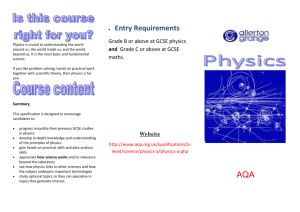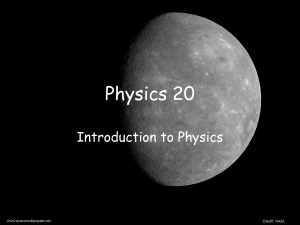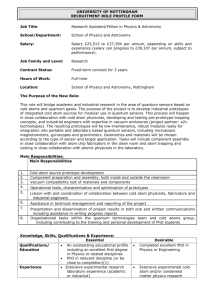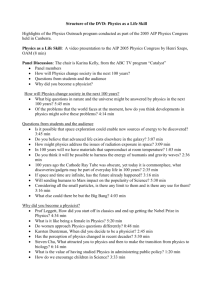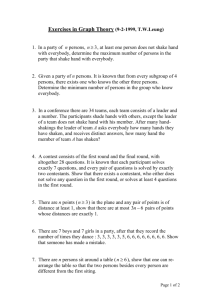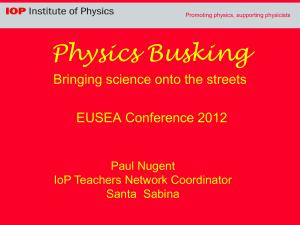Physics 1 - Westmount High School
advertisement
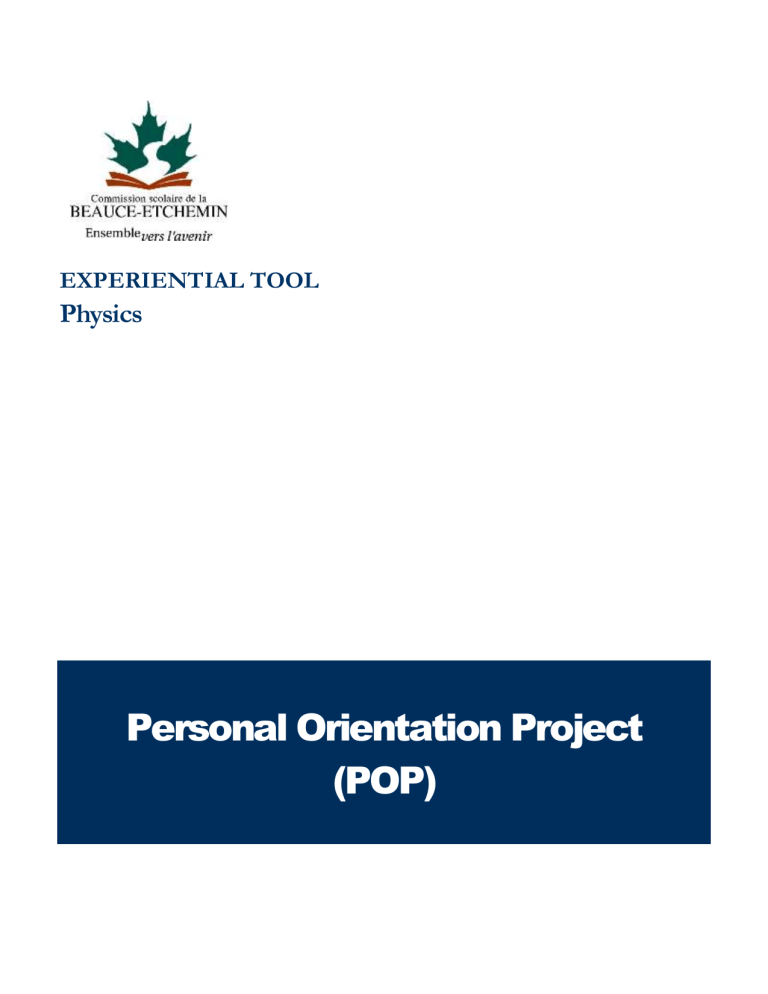
EXPERIENTIAL TOOL Physics Personal Orientation Project (POP) PHYSICS Activity Guide This tool kit is intended solely as a guide; the information found herein is not meant to be exhaustive. The websites mentioned in this tool kit may no longer be active or may direct you to sites containing information you may find inappropriate. Please check these links before using them with students, as we cannot guarantee they will work. Moreover, the Commission scolaire de la Beauce-Etchemin cannot be held responsible for the contents of these sites, nor for any omissions, errors or inaccuracies found in this tool kit or for any consequences arising from such omissions, errors or inaccuracies. Note that the Creative Commons licence applies only to the text found in this tool kit and to the photographs or images that are clearly indicated as not being copyright protected. Any use or modification of photos that are copyright protected for purposes other than for the Personal Orientation Project program, in whole or in part, is strictly forbidden. 2004, http://creativecommons.org/licenses/by-nc-sa/2.5/ca/deed.en_ca You are free to copy, distribute and transmit this work. You are free to adapt this work. Attribution. You must attribute the work to its original author. Noncommercial. You may not use this work for commercial purposes. Share alike. If you alter, transform or build upon this work, you may distribute the resulting work only under the same licence as this one. This work, with the exception of any photos or images that are copyright protected, may be reproduced in full or in part provided the source is acknowledged. Document number: 1 Document version: 2.0 Property of the Commission scolaire de la Beauce-Etchemin, © 2007 i P H Y S I C S Table of Contents General Information 1 Credits 3 ACTIVI TY 1 Introduction 4 ACTIVI TY 2 At work as an everyday physicist ACTIVI TY 3 At work as an astronomer ACTIVI TY 32 5 People in physics ANSWER 21 4 At work as a particle physicist ACTIVI TY 10 43 KEY Activity 1 79 Activity 2 80 Activity 3 80 Activity 4 81 Activity 5 84 APPENDI CES A– A (very) short history of modern astronomy 85 B– Gender representation in physics: Where are all the women? 86 C– Suggested physics resources 88 ii P H Y S I C S General information 1 P H Y S I C S List of materials: The following list itemizes all the materials and resources required to complete this tool kit on physics. Physics Activity Guide Multimedia computer One (1) ping-pong ball One (1) tennis ball Bottle of liquid honey (500 ml) Bottle of vegetable oil (500 ml) One (1) clear disposable cup per student Metal Slinky Piece of wool fabric (20 cm by 20 cm) Bar magnet Piece of string (30 cm long) Metal plate (at least twice as big as the magnet) Mirror (10 cm by 10 cm) Blank CD Piece of Styrofoam (20 cm by 20 cm by 2 cm) Utility knife Bag of marbles Piece of thick, resistant paperboard (20 cm by 20 cm) Websites for activities: Amazing Space: http://amazing-space.stsci.edu Google Maps: http://maps.google.com Quantum Diaries: www.interactions.org/quantumdiaries/index.html Physics.org: www.physics.org 2 P H Y S I C S Websites for activities (cont’d): Sky-watching blog: http://ppo.wiki.zoho.com University of Hawaii Institute for Astronomy: www.ifa.hawaii.edu/ Ruben’s Tube: www.liensppo.qc.ca Other recommended websites: Answers.com: www.answers.com CERN: http://public.web.cern.ch/public Contributions of 20th Century Women to Physics: http://cwp.library.ucla.edu Curious About Astronomy? Ask an Astronomer: http://curious.astro.cornell.edu/ Kepler’s Laws: www.astro.uiuc.edu/projects/data Physics videos: www.liensppo.qc.ca Science Daily: www.sciencedaily.com Sky Maps: www.skymaps.com The Particle Adventure: http://particleadventure.org Physics Central: www.physicscentral.org Wikipedia: http://en.wikipedia.org 3 P H Y S I C S Credits Conception: Marjorie Gonzalez PhD candidate in Physics and Let’s Talk Science Partnership Program Coordinator, McGill University Rhiannon Gwyn PhD candidate in Physics, McGill University Audrey MacLeod MSc student in Physics, McGill University Jonathan Stolle MSc student in Physics, McGill University Adaptation: Nancy Kerec POP contract professional Marsha Gouett Reviser and proofreader Avis Anderson Final reviser and researcher Special thanks: Rhys ap Gwyn For creating the “Department of Physics / People in Physics Investigation” badge that appears in Activity 5. Some of the images in this work are used with permission, whereas others are in the public domain or under GNU Free Documentation Licence. See the footnotes for each image to determine whether the image falls under the Creative Commons licence. 4 P H Y S I C S Activity 1 Introduction Human beings have always been curious about the world around them, and we have come to understand that we can learn about the world by observing and thinking about everything in it. First, we observed that the Universe obeys a set of fundamental laws. The goal of physics is to describe and understand these laws by using a combination of theoretical reasoning (i.e., thinking about them) and experiments. We are then able to use these fundamental laws to our benefit to create items that improve our lives such as cars, airplanes, microwaves and computers. We have come to understand a great deal about the world around us. However, we still do not understand everything about it, and there are many areas in which new discoveries are still being made. With each discovery, we gain a better understanding of how the Universe works. The purpose of this physics tool kit is to provide you with a glimpse of what it is like to be a physicist. Physics is a large field of study, so you will concentrate on a few areas related to it. You will discover some of the history of physics and its impact in our world and then experience it firsthand by conducting several experiments. Although a large number of cutting-edge physics experiments are being carried out all over the world, they unfortunately require state-of-the-art facilities that cannot be re-created easily. Therefore, while working with this tool kit, you will perform simple yet informative experiments related to very important physics concepts. This will give you an idea of a physicist’s work: wanting to know something about the world around us, thinking of a way to test it, building the facilities to do it, performing the experiment and finally thinking about what the results tell you about the world. Albert Einstein, perhaps the greatest physicist of all time, was once a high school student like you who wondered what he would become in life. He ended up changing the way we see the world by choosing to study physics. Does physics really matter? Albert Einstein’s story A discovery in physics can have far-reaching effects. For example, Albert Einstein was voted TIME magazine’s “Person of the Century” in 1999. Among his great contributions to society are the theory of relativity, his explanation of the Brownian motion of molecules and his explanation of the photoelectric effect. 5 P H Y S I C S General relativity is a theory of gravity. Instead of interpreting gravity as being the result of a force, Einstein showed that it curves both space and time. One consequence of this is that, although light does not have mass and was previously thought to have been unaffected by gravity, it is in fact affected by massive objects. Light will bend around these massive objects (such as black holes) because mass bends space and time (see Figure 1.1). Other objects, like a passing star, will also curve towards the massive object because of the warped space. The theory of relativity gives us insights into how astronomical objects interact with each other. Figure 1.11 In his explanation of the Brownian motion of molecules, Einstein explained how molecules move when they are in groups and provided the first evidence that atoms existed (before they were discovered in experiments). As for the photoelectric effect, Einstein explained that atoms contain positive and negative charges and that, by shining light on them, you can separate these charges. Among other things, this work led to our understanding of how light can be thought of as being both a wave and a particle. In short Einstein influenced many areas of physics with his work. Even so, why would Einstein be considered such an important person, especially out of all the politicians, scientists, doctors and others who could have been named “Person of the Century” by TIME magazine? It is mainly because, in the end, his work has given us a better understanding of how the Universe works. Nuclear energy, electronics, the Big Bang, quantum physics and countless other touchstones bear his imprint. In the same way, modern-day physicists continue to explore the world around us, making new discoveries every day and changing the way we live and think about the Universe. 1. An example of how general relativity describes space-time: as an area that can be distorted by the presence of heavy objects in the Universe. “Earth in a gravitational field,” digital image by Dr. David Champion. Used with permission. 6 P H Y S I C S What does it take to be a good physicist? Einstein himself said, “The important thing is not to stop questioning.” If you constantly question the world around you, then you would make a good physicist! Curiosity, combined with the ability to ask the right questions, is the first step to being able to answer those questions. Some other characteristics of a good physicist are computer and mathematical skills and creativity. All of these abilities help with problem-solving, which is an important aspect of working in physics. Why not take the time to record some of the abilities/skills you have that might make you a good problemsolver? Feel free to use the skills already mentioned and/or come up with some of your own. Name at least three qualities that make you a good problem-solver. What do physicists really do and where do they work? Physicists study a wide range of physical phenomena, from quarks (the tiny constituents that make up an atom’s nucleus) to the massive stars and black holes that make up entire galaxies. For example, astrophysicists study astronomical objects, such as planets and black holes (see Figure 1.2), and the laws that govern them. Other physicists, who work in the field of nanotechnology, are concerned with the smallest of matter (on the scale of individual atoms) (see Figure 1.3). There are also physicists who study objects of every size in between, which makes for a wide variety of possible fields in which to work. Figure 1.22 Figure 1.33 “Artist’s impression of stellar-mass black hole,” digital image, NGC 4472 (January 3, 2007), ESA/NASA/Felix Mirabel, Chandra X-ray Observatory (http://chandra.harvard.edu : accessed July 11, 2007). This image may be used for non-commercial educational and public information purposes. 2. A representation of an individual lithium atom. Black dots are electrons, red dots are protons, and blue dots are neutrons. “Stylised lithium atom,” digital image by Halfdan, Wikimedia Commons (http://commons.wikimedia.org : accessed 10 July 2007). This image is under GNU Free Documentation Licence. 3. 7 P H Y S I C S Physicists work in a variety of settings, including research labs, medical labs, universities and secondary schools. Because physicists have a wide variety of skills, many of them choose to work outside the field of physics while applying the skills they learned as trained physicists. Below is a breakdown of where physicists currently work according to data from the Institute of Physics (see Figure 1.4). “IT” stands for information technology and is a wide field of employment, as are industry, finance and research. Some physicists work in the telecommunications industry, others in satellite design, medicine, meteorology and teaching, to name but a few of the many possibilities. As well, large numbers of physicists work in interdisciplinary fields such as biophysics, chemical physics, medical physics, geophysics, oceanography and seismology. Physicists also design research equipment. This equipment often has additional unanticipated uses. For example, lasers are used in surgery, microwave devices are used for ovens, and measuring instruments can analyze blood or the chemical content of foods. Other physicists also work in inspection, testing, quality control and other production-related jobs in industry. Some students who complete their first degree in physics to obtain a good scientific background then take an engineering degree to enhance their ability to apply their skills in industry. In short, studying physics will not limit your job opportunities! On the contrary, you will learn valuable skills and gain important knowledge that will make you a great employee or employer in whatever career you choose. Figure 1.44 4. Typical sectors where physicists are found. Image by Marjorie Gonzalez based on values obtained from the Institute of Physics (www.physics.org : accessed August 3, 2007), a London-based scientific organization with a worldwide membership. Used with permission from the McGill Let’s Talk Science Partnership Program. 8 P H Y S I C S Put yourself into a physicist’s shoes A series of blogs written by physicists from around the world is available on the Quantum Diaries site at www.interactions.org/quantumdiaries. To read the blogs, click on “The Physicists” in the list on the left-hand side of the page. One of these physicists is David Waller. To read his blog, scroll down to “David Waller” and click on his name or photo. Answer the following questions about him: 1) Where was David Waller born? 2) Where did he work when he wrote this blog? 3) What happened to him in grade 9 that might have discouraged him from becoming a physicist? 4) Why does he like being a physicist? Find out how a few things work You should now feel like you know a bit more about what physicists do and where they work. Next, we will start exploring the physics behind how some everyday household appliances work. How do a microwave, mirror and toaster work? To be able to fill in the blanks in the three sentences below, visit the following website: www.physics.org. Click on “Interact” in the menu bar at the top of the page and then on “Physics Life.” Select the Flash version of the Physics Life cartoon street. This game lets you click on objects in order to find out how they work. Click on the house to enter it and locate the three household appliances. When you click on an item, an explanation of how it works will pop up. Find the information needed to fill in the following sentences: 1) Microwaves heat up food by heating up the ___________ ___________ in the food. 2) A mirror is made of a sheet of ___________ where one side is coated with ___________ or ______________. It is the ___________ ___________ that reflects images. 3) A toaster works by passing an ______________ ___________ through ___________ ___________ that heat up. 9 P H Y S I C S A preview of the rest of the tool kit This tool kit contains other sections for you to work through, most of them with both mandatory and optional parts. This will allow you to spend time on them according to your interests. The rest of the tool kit is divided into the following sections: Activity 2: At work as an everyday physicist This section contains many simple experiments that will give you an idea of what physicists do in their everyday work as they try to find out how everything around us works. Activity 3: At work as an astronomer In this section, you will find out what astronomers do, what they use to do it and where they work. Activity 4: At work as a particle physicist Aspects of the work of particle physicists, such as what they work on and where they work, will be examined in this section. Activity 5: People in physics This simple optional investigation activity will introduce you to some important physicists, their lives and the contributions they have made to the field. You will learn about the backgrounds of people who have become physicists as well as other interesting details about their lives. 10 P H Y S I C S Activity 2 At work as an everyday physicist Physicists perform experiments to find out how everything around us works. These experiments can include manipulating atoms one by one in laboratories or observing galaxies in outer space using a telescope. In this section, you will perform experiments with everyday objects and think about how the physics behind them is actually put into practice by physicists in their work. Modern physicists work in large, complex laboratories, but what they do comes down to figuring out how the world works and why. Warm-up activity List five examples in which physics is used, seen or experienced in everyday life and explain why you have chosen these examples. Return to the Physics Life cartoon street on the Physics.org website (www.physics.org) to see how physics is at the heart of almost every object of our everyday life. (See page 8 for instructions on how to get to the Physics Life cartoon street on this website.) Mechanics Anything that you see moving is an example of mechanics. This includes a speeding car, people playing sports, and leaves blowing in the wind. For this section, imagine that you are a physicist working in a lab where you have to make one small object (for example, an atom) move very fast. What is conservation of momentum and how does it work? Your first thought may be that if you make another object hit your atom and thus transfer its momentum to it, this will make your atom move. So what kind of object do you need to use: a small one or a large one? To figure this out, try the following experiment: Step 1 What do you think will happen if you drop a ping-pong ball and a tennis ball at the same time with the ping-pong ball resting on top of the tennis ball? 11 P H Y S I C S Step 2 Take the ping-pong ball and the tennis ball provided in your kit and drop them as described. Observe what happens and compare it with your answer. What is different? Step 3 What do you think will happen if you drop the two balls with the tennis ball resting on top of the ping-pong ball? Record what you think will happen, then drop them as described and record what happens. Momentum is a measure of the motion of a body equal to its mass multiplied by its velocity (mass velocity).5 Momentum is a property of all moving objects. When objects collide, momentum is conserved. Thus, when the tennis ball and ping-pong ball collide with the ping-pong ball on top, the ping-pong ball bounces fairly high because the tennis ball (which is heavier or, in other words, more massive) transfers some of its momentum to the ping-pong ball. In the reverse case, the tennis ball will not bounce very high because the ping-pong ball (which is smaller or less massive) is not moving fast enough to transfer much of its momentum to the tennis ball. Therefore, if you want to make your atom move, you have to use either a larger object moving at a low speed or a smaller object that is moving much faster. To try another fun experiment with this concept, look at the Newton’s cradle (see Figure 2.1) available on this site: www.physics.org. Click on “Interact” in the menu bar at the the page and then scroll down and click on “Newton’s Cradle.” the number of spheres you want and then try lifting one ball the system run. Then try lifting two balls. Describe what top of Select and let happens. Figure 2.16 What is conservation of energy and how does it work? Now, let’s say you want to make your atom move without making it collide with anything else. What can you do? In this case you could try transferring energy from something else to your atom. As an example, try the following simple experiment: Drop a pencil from your hand onto the ground and watch it fall. 5. See www.answers.com/topic/momentum for a fuller explanation of what momentum is. 6. Newton’s cradle. “The cradle in motion,” still of an animated image by Dominic Toussaint, Wikipedia (http://en.wikipedia.org : accessed July 10, 2007). This image is under GNU Free Documentation Licence. 12 P H Y S I C S When the pencil is held in your hand, above the ground, it has potential energy. When it falls, the potential energy is converted to kinetic energy, which makes it move. Once it hits the ground, it transfers all of its kinetic energy to the ground. Similarly, conservation of energy also makes a pendulum move (see Figure 2.2). There are also other types of energy. You might be familiar with the term “voltage” in electricity (which is energy per unit charge) or with the idea that hot objects have more thermal energy per unit mass than cold objects (though thermal energy is related to the kinetic energy of small particles). The chemical energy in food is stored as chemical energy in your body and is used to make you move (see Figure 2.3). Light energy is used by plants for photosynthesis. The chemical energy in fuel is released, allowing a vehicle to move, and so on. In the scenario above, for example, if you know that your atom has an electric charge (either positive or negative), you can apply a voltage to it, and the electrical energy that transferred to it will make it move. Figure 2.27 Figure 2.38 7. Conservation of energy in a pendulum. Image created by Marjorie Gonzalez. Used with permission from the McGill Let’s Talk Science Partnership Program. 8. Transformations from one type of energy to another. Image created by Marjorie Gonzalez. Used with permission from the McGill Let’s Talk Science Partnership Program. 13 P H Y S I C S What is friction? Now imagine that you have successfully made your atom move. Great! But what if you observe that it is slowing down very fast? Why is it slowing down? One thing that could be affecting your atom is friction. Friction can be defined as “a force that resists the motion of any object through its interaction with the surroundings.”9 The shape, size and material of your object and its surroundings all affect friction. As an example, try the following experiment: Step 1 Slide an eraser and a coin along your desk. Then try sliding a pen and rolling a marble or ball. Write down what you observe; for example, how far each object moves. Step 2 Based on your results, which object moves the farthest before stopping? Step 3 If you were to try these experiments on another surface such as ice, what do you think would happen? These questions are some of the ones that physicists have to keep in mind all the time when they want to make things move. In the case of atoms, they are so small that the most important cause of friction is an atom bumping into another atom or a molecule by mistake. Therefore, physicists always try to conduct their experiments in closed setups where they can carefully control all aspects of the experiment. Very often they will build a vacuum chamber where all the air, dust and other causes of error (and friction) have been removed. Although friction can slow down a moving object, it can also make something move. Without friction, we would not be able to walk because it is the force of friction from the ground onto our feet that propels us forward. Wheels work in a similar way. Tires are designed so that friction allows for motion while the wheel rolls. 9. R. Serway and R. Beichner, Physics for Scientists and Engineers with Modern Physics (Forth Worth, TX: Saunders College Publishing, 2000), pp.131-133. 14 P H Y S I C S Fluids Fluids are typically liquids or gases. These substances readily deform when a force (gravity or a push) is exerted on them. Imagine now that you are a physicist, and you have three fluids available to you for an apparatus you are building. However, you will use only one in your experiment: the one that takes the least force to move. To test this out, try the following exercise: Step 1 Take the bottles of honey and oil provided in the tool kit. Pour some water into a transparent disposable cup. Step 2 One by one, move the bottles and the cup of water in circles or from side to side. Pay attention to how the fluids move inside their containers. Step 3 Rank the fluids according to how easily they move. The property you are measuring is called “viscosity,” which measures how much a substance resists movement. The fluid you ranked first has the lowest viscosity since it resisted motion the least, and you would use that one in your experiment. Thermodynamics and heat transfer Thermodynamics deals with general laws relating to energy in systems. A system is anything that you define it to be: your hand, a planet, or your desk and its contents. For example, a pot of water can be a system. One thing you may already have noticed is that a pot full of water takes a lot longer to heat up than an empty pot. This occurs because the energy has to travel into both the pot and the water, so less energy goes into the pot itself. Imagine that you are now performing a physics experiment where you need to keep an object cold. What can you do to make sure this happens? What if you were to make the object transfer its heat to another object? If you were to try this and had the choice of using a metal or plastic object, which one would you choose? Try the following conduction experiment and see: Step 1 Find a nearby metal object as well as a plastic object. Step 2 Touch each one of these objects. Which one feels cold to the touch? 15 P H Y S I C S Step 3 Now place your hand next to the object without touching it. Do you still feel cold? This is an example of conduction: the transfer of heat (and thus energy) from hot to cold through contact (see Figure 2.4). Metals feel cold when you touch them because they are good heat conductors. They conduct heat away from the skin on your hand, which the temperature receptors in your skin register as a drop in temperature, so the surface of the metal feels cool. How much heat is transferred is related to the material itself: some materials are insulators and do not allow heat to be transferred, while others are conductors and allow for rapid heat transport. In this case, then, you could use a metal object to keep your experiment cold. In reality, there are other conductors that are easier to work with that you could use in experiments to keep things cold (e.g., water or liquid nitrogen). Figure 2.410 Waves A large number of physicists work with waves and their properties. For example, astronomers use the wave properties of light to observe objects in the Universe. Other people who are not physicists, such as those who design and build musical instruments, also need to be familiar with waves. These next activities will introduce you to the basic properties of waves. How do waves move? Take the Slinky provided and lay it stretched out on its side. Carefully push and pull one end of it a few times, making sure not to lift it in the process. The waves caused by this motion move in a longitudinal direction. Now move one end of the Slinky from side to side. The waves caused by this motion move in a transverse direction. 10. Illustration of heat conduction. Image created by Marjorie Gonzalez. Used with permission from the McGill Let’s Talk Science Partnership Program. 16 P H Y S I C S In longitudinal wave motion, the different parts of the Slinky oscillate back and forth from their original positions. Sound waves also move through air in this way, compressing the air as they travel through it. In transverse wave motion, different parts of the Slinky do not get compressed but move from side to side instead. This is the way that light moves. Standing waves and music Step 1 Hold one end of the Slinky in a fixed position and move the other end from side to side. The waves you create will be reflected back to you. Sometimes you will see that, when the new waves interact with the reflected ones, you will have points on the Slinky that move more than they did at first and others that do not move. Standing waves are waves that remain in a constant position. This can happen when, for example, two waves with the same characteristics are moving in opposite directions, continuously destroying and enhancing each other, creating the effect of a wave that does not change position. These waves are very often found in music. For example, the vibration of a guitar string causes the surrounding air to vibrate with certain frequencies. These frequencies are emitted by the standing waves possible on a guitar string. (These waves are like those in the Slinky in step 1 above; their wavelengths have a fixed end at the point where the guitar string is held down by the guitar player.) There is an interesting experiment on the Internet with a Ruben’s tube that allows you to see the different standing waves that give rise to different musical tones. A Ruben’s tube consists of a tube poked with holes and sealed at both ends. One seal is attached to a speaker and the other to a supply of flammable gas, which is pumped into the tube and lit. Where the transverse sound waves compress the air in the tube, the flame is high: gas and air are pushed out of the tube. Where the compression is low, the flame is low. You can watch a demonstration of the effect on the following site: www.liensppo.qc.ca. Click on “POP Links” and then scroll down to click on “Ruben’s Tube” under the “Physics” section to watch the clip. Do all waves make standing waves in a Ruben’s tube? Why or why not? Electricity and magnetism Physicists use the properties of electricity and magnetism in their experiments all the time. Why? Mainly because they can then transfer energy from one object to another and easily control the way in which the objects move. 17 P H Y S I C S For example, imagine that in your experiment you want to make electrons move from one place to another. How do you do this? First, you must remember that electrons have a negative electric charge. How can you use this to your advantage? To see how this works, try this simple electricity experiment: Step 1 Take the piece of wool fabric provided in your kit and rub it against any plastic object. Step 2 Holding the piece of wool, touch something in your classroom made of metal that is in some way connected to the ground such as the metal around a blackboard or window, a door frame, a door knob or some other metal object. Step 3 Did you feel a shock when you touched the metal? Electricity consists of positive and negative charges. Wool is a material that likes to “give away” negative charges (i.e., electrons), while plastic does not mind accepting extra ones. After you rub the plastic object, the piece of wool has more positive charges than negative, and so does your body because you are in contact with the wool. If you then touch a material that allows charges to move freely (a conductor), your positive charge will attract electrons from it, and the flow of these charges into your body will create a shock. Similarly, if you are a physicist wanting to make electrons move from one place to another, you can build up positive charges in another material, and your electrons will then be attracted to it. Figure 2.511 11. Magnetic lines of force of a bar magnet shown by iron filings on paper. Practical Physics (New York: Mcmillan, 1914); digital image, Wikimedia Commons (http://commons.wikimedia.org : accessed July 10, 2007). This image is in the public domain. 18 P H Y S I C S Now, what if you not only want to make electrons move from one place to another in a straight line, but you also want to control the direction in which they move? How would you do this? Do you think that magnetism is involved? The shape of the magnetic field of a bar magnet is shown in Figure 2.5. Try this simple magnetic experiment: Step 1 Tie the bar magnet to a string. Firmly hold the end of the string up in front of you and, with your other hand, lift the magnet to one side and let it go. The magnet will move like a pendulum and will come to rest slowly. How long does it take for it to stop? Step 2 Then do the same thing again, but this time place the metal plate from your kit very close to the magnet. How long does it take to come to rest this time? A brief explanation is that a changing magnetic field causes charges in a conductor (in this case your metal plate) to move. You can see this effect because the moving charges make the metal plate act as a magnet. The poles of this new magnet are oriented in the opposite direction to the original magnet. The same poles of the two magnets then face each other and repel each other, making the pendulum oscillate for a longer time.12 Since, as stated above, the movement of the magnetic field causes the electrons in the metal plate to move with the field, you can then use this principle to make the electrons in your experiment move in any direction you want by using magnets. Optics and light Optics is the branch of physics that studies light. Light can be described in terms of two different models: particles and waves. Return to the Physics Life cartoon street on the Physics.org website (www.physics.org) and click on the sundial for an example of ray optics. (See page 8 for instructions on how to get to the Physics Life cartoon street on this website.) The speed camera on the street is an example of wave optics, and the CD/DVD player in the house is an example of both particle and wave optics. Physicists are currently studying a very exciting field called quantum mechanics that deals with how light can be thought of as being both a particle and a wave simultaneously! How do they know that this is true? Try the following simple experiments to get an idea: 12. This repulsive effect can be permanently maintained with superconductors and cause levitation, which is used in maglev trains. (For more information on maglev trains, search for “maglev train” on the Wikipedia site at http://en.wikipedia.org). 19 P H Y S I C S Light as a particle Step 1 Take the mirror included in your kit and look at your reflection in it. As you know, a flat mirror creates a nearly perfect reflection. This occurs because light rays bounce off you and then reflect off the mirror and into your eyes (see Figure 2.6). This is only possible because light is made up of little particles that can bounce off other objects, just like the ping-pong ball and tennis ball you used earlier in this section. Figure 2.613 Light as a wave Step 1 Take the CD included in your kit and turn it upside down. Try to shine light from your surroundings directly onto the CD. Step 2 What patterns of light do you see on the CD? Try drawing the patterns you see and indicate how many different colours there are. 13. Illustration of how a flat mirror creates an image. Image created by Marjorie Gonzalez. Used with permission from the McGill Let’s Talk Science Partnership Program. 20 P H Y S I C S This effect, called diffraction, is possible because the “white” light that is all around us can also be thought of as a collection of waves, each having a different colour. Diffraction occurs when a wave is bent or spread (see Figure 2.7). Therefore, what you see on the CD are the individual waves that make up light bending by various amounts and being separated into their individual colours. This could only happen if light were a wave in addition to being a particle! Figure 2.714 Summary question Take the five examples you listed at the beginning of this activity and describe what physics concepts are relevant in each example. A wave being diffracted around the corners of an opening. “Numerical approximation of diffraction pattern from a slit”; image by Dick Lyon, Wikipedia (http://en.wikipedia.org : accessed July 10, 2007). This image is in the public domain. 14. 21
